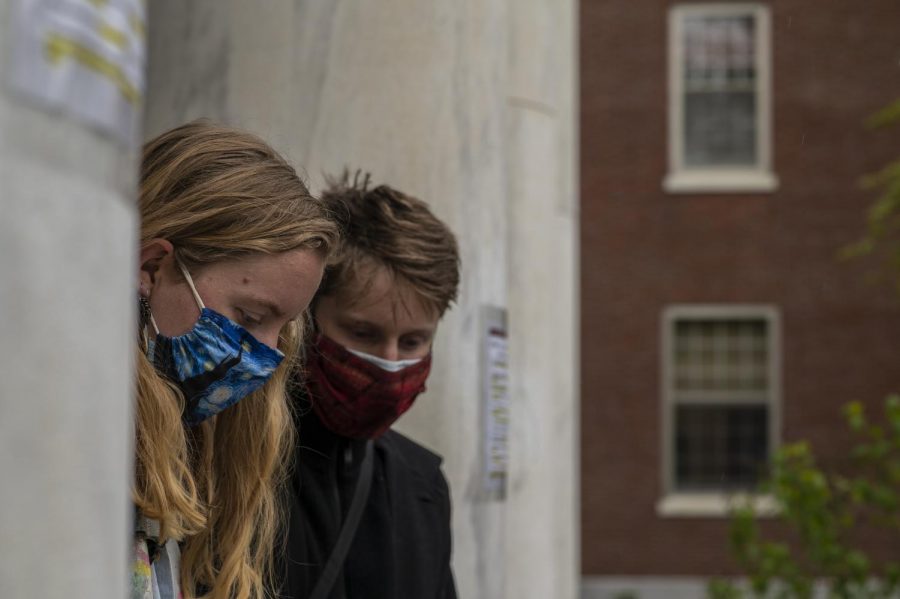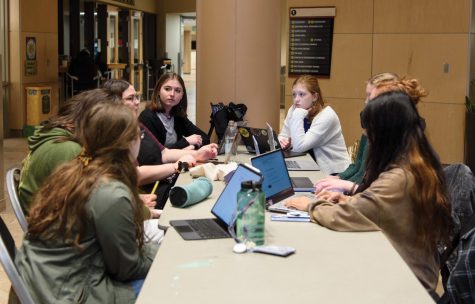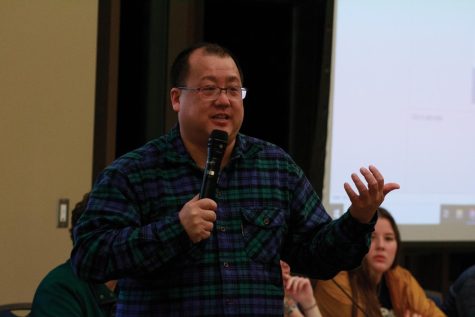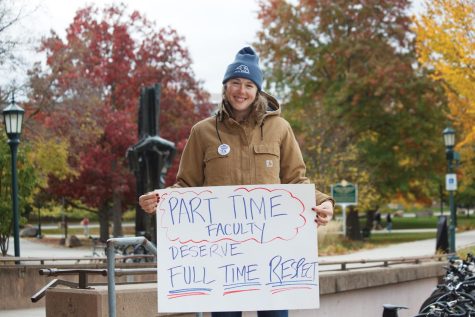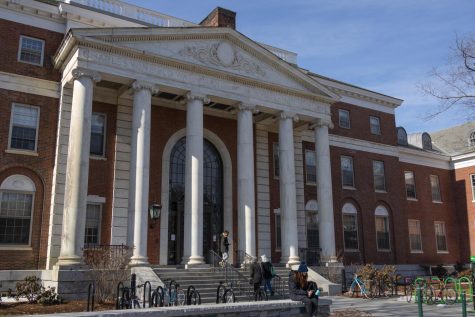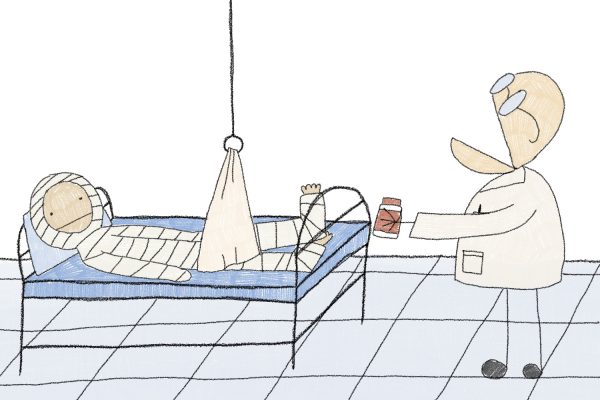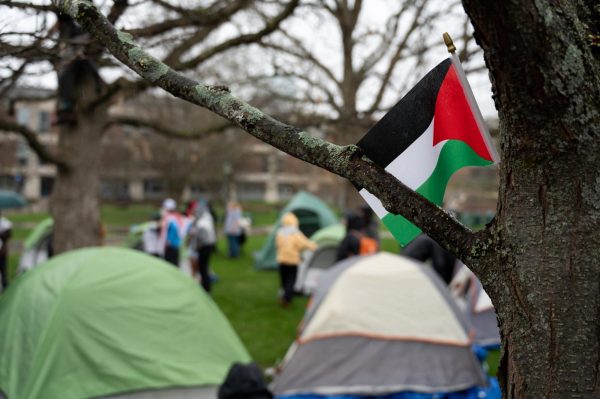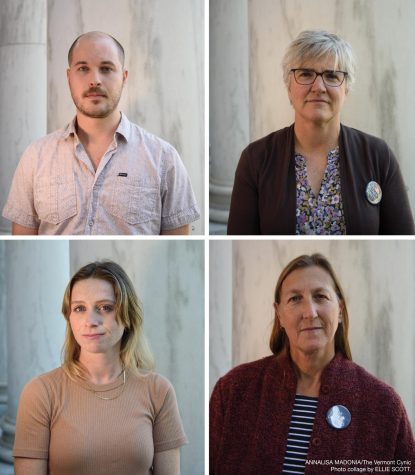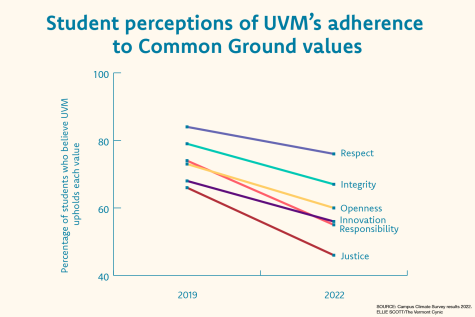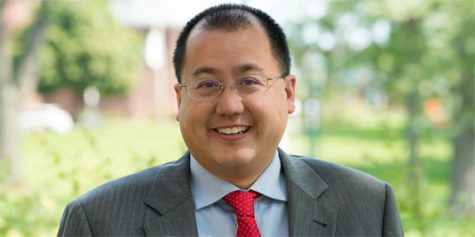Through the eyes of survivors: The systemic mishandling of sexual violence at UVM
Junior Athena Hendrick and Senior Colbalt Tolbert stand on top of the Waterman steps preparing to speak to a crowd of thousands May 3.
Editor’s note: One survivor interviewed for this piece has had her name changed to a first-name pseudonym for legal reasons.
The story of a survivor of sexual violence who shared their story has sparked a University wide movement, revealing systemic issues in the way UVM handles cases of sexual misconduct.
A resounding message of condemnation against UVM’s sexual assault reporting process has mounted rapidly, after senior Athena Hendrick made their Instagram post April 25 and more than 120 other survivors of assault at UVM followed in sharing their stories.
In response to the countless stories that have been shared, thousands are calling on UVM to investigate and reform operations in their Affirmative Action and Equal Opportunity Office, the department tasked with the handling of Title IX reports.
For many survivors, the process of reporting their assault has proven to be retraumatizing and unsatisfying, which they attribute to AAEO’s poor handling of sexual assault case reports, according to many of their statements on social media and comments made at a walkout May 3.
Multiple UVM students have made Instagram posts directly calling out Kate Spence, a Title IX investigations officer, for the way she personally directed their case proceedings.
Kate Spence was unresponsive to the Cynic’s numerous requests for comment, deferring the requests back to Stanton.
“I am responding to your inquiry to Investigator Kate Spence,” Stanton stated in a May 7 email. “We are very sorry for any pain the students are experiencing.”
Consent: AAEO’s definition versus their actions
Three survivors the Cynic spoke with, including Hendrick, said they were intoxicated during the nights of their assaults. In all three survivors’ cases, Title IX Investigator Kate Spence was the lead investigator, which means she conducted interviews and guided the direction of the report.
According to AAEO’s Sexual Misconduct and Harassment Definitions, being incapacitated by drugs or alcohol makes all sexual encounters nonconsensual.
“A person who is incapacitated by alcohol, drugs or any other factor cannot give consent,” according to their website. “This means that if your partner or a person you want to have sex with is really drunk or has taken drugs, [they] probably cannot give consent.”
By UVM AAEO’s definition, sexual assault is a sexual act that occurs with threats, coercion or without consent.
Despite AAEO’s own definition of assault, Spence did not deem any of these three survivors’ cases to be sexual assault, and none of their abusers faced consequences.
The final report has a section called ‘findings of fact,’ and all of those items that go in there need to be indisputable, and every single thing that the person who raped me said without anybody there, any recording, anything to back it up, everything was put in that.
— Junior Cassia Harting-Smith
Hendrick said during their investigation, Spence showed little regard for their feelings when she invalidated Hendrick’s claims by calling their experience consensual.
“She said that because I didn’t throw up, and wasn’t falling over, I was at the ability to consent,” Hendrick said.
Despite Hendrick explaining their unusual incapacitated state at the time of the assault, they said Spence also wouldn’t entertain the possibility of a drugged drink being involved.
“When I said that things started when I was unconscious, [and] I’ve never thrown up from alcohol and I was told by the police that they thought I was drugged, Spence said because there was no drug test she couldn’t say that I was,” Hendrick said.
Like Hendrick, junior Cassia Harting-Smith was also intoxicated at the time of her assault and questioned whether she had been drugged, but Spence paid little attention to these concerns, Harting-Smith said.
“Kate Spence had basically stopped taking notes during certain parts of the interview, and my therapist [who was present at the interview] told me they noticed those were the parts where she was talking about the possibility that I had a drug or something put in my drink,” Harting-Smith said.
Amy, another survivor, also recalls being extremely intoxicated during the time of her assault, which caused her to be confused and not remember certain points of the night, she said.
“I was drunk, really drunk,” Amy said. “I don’t remember all of that night, I remember crying a lot and being very confused.”
“It was horrible and it’s still really hard because you’re just reading what Kate Spence had to say and not only did she say there was insufficient evidence to prove any finding of responsibility, but she told me my entire assault was consensual,” Harting-Smith said.
Reading through her report, Harting-Smith was frustrated by the way Spence categorized information.
“The final report has a section called ‘findings of fact,’ and all of those items that go in there need to be indisputable, and every single thing that the person who raped me said without anybody there, any recording, anything to back it up, everything was put in that,” Harting-Smith said.
Understanding the reporting options
Hendrick also had a hard time with the results of their report, after there was “not enough evidence found,” and they were simply offered an extended no contact order from the person they said raped them, Austin Wieland.
Wieland did not respond to the Cynic’s multiple requests for comment.
“I was really devastated,” Hendrick said. “I was devastated because I went through the system and it just demonstrated that it wasn’t serving its purpose.”
However, Hendrick said reporting felt like the only option to ensure theirs’ and others’ safety on campus.
“I went through [reporting], because it’s a huge coping mechanism […] and because I felt unsafe, and I couldn’t go to my classes,” Hendrick said.
I decided to go with Title IX because I was told the criminal investigation was probably going to last between two to five years of my life. I don’t want to be here in two to five years.
— Junior Athena Hendrick
For Harting-Smith, who was assaulted in her dorm during her first year, reporting her assault was done out of anger and the need for support, she said.
“There was no support from my friends, and my family didn’t know, so I guess it was the first thing I could think of as an attempt to try to be heard,” Harting-Smith said.
When Amy chose to come forward and report her assault to AAEO, her friend who had gone through a similar process recommended she reach out to Judy Rickstad, the University’s only Campus Victim Advocate.
Rickstad coordinates services for students that experienced sexual assault, stalking, relationship violence and domestic violence, according to The UVM Women and Gender Equity Center.
However, with only one victim advocate on campus, it has proven difficult for students like Harting-Smith to get in contact with Rickstad right away.
“When I first reached out to the school this past summer, it took a lot to get through,” Harting-Smith said. “They didn’t reply right away, and I know now that’s because Judy is booked, she’s got a lot going on.”
It wasn’t until Harting-Smith left messages for the Women’s Center multiple times and her therapist reached out, that she finally received a response, she said.
“I left a few messages, there were no replies to those, then I emailed Judy as well,” Harting-Smith said. “I think the thing that really got her response was me telling my therapist they’re not replying … and she called up the Women’s Center.”
Once in contact with Rickstad, Harting-Smith said she set up a meeting with her to discuss the different options she had for reporting her assaulter.
“One option was to do nothing, another was go to the police, then [she] explained that I could go through an [alternative resolution] through the school but settle with my assaulter and come to some sort of agreement, or I could go through a formal investigation,” Harting-Smith said.
The alternative resolution is listed as “Option 1” in the University Operating Procedure on Handling and Resolving Discrimination, Harassment and Sexual Misconduct Complaints, while the investigatory resolution is listed as “Option 2.”
“The purpose of an alternative resolution is to facilitate a dialogue that allows a Complainant to express the harm they have experienced, and the Respondent to understand the impact of their conduct on Complainant,” the document stated.
The alternative resolution is not a disciplinary process, but rather seeks to educate the parties without rendering an institutional policy decision, according to the document.
The investigatory resolution has the potential to end in sanctions for the Defendant, according to the University’s Operating Procedure on Discrimination, Harassment and Non-Title IX Sexual Misconduct Sanctioning Procedures for Student Respondents.
Possible sanctions including probation, educational sanctions, fines or fees, community restitution, suspension from res halls, suspension from UVM and dismissal, according to the document.
Ultimately, Harting-Smith felt the formal Title IX investigation was her only option after considering the other choices, she said.
Hendrick also decided not to pursue a criminal investigation due to their distrust of the police and the potential length of the investigation, though they did give a statement to the police in order to make a safety plan, they said.
“I decided to go with Title IX because I was told the criminal investigation was probably going to last between two to five years of my life,” Hendrick said. “I don’t want to be here in two to five years.”
Amy also chose to eliminate the police investigation from her options given the poor reputation that police have gotten for traumatizing sexual assault survivors during interviews.
“Going to the police was really out of the question because it would only have been re-traumatizing,” Amy said.
Eventually, Amy decided the formal Title IX investigation was her only choice given the alternative resolution could only involve a settlement, rather than a punishment for her abuser, she said.
Although discouraged by the options, Amy was grateful for the support and validation Rickstad offered her during that time, she said.
“She’s very motherly, and it was definitely the comfort I needed at that time,” Amy said. “There was a lot of validation coming from her that I was not giving myself and I didn’t know anything about assault so it was helpful to have someone.”
Although Harting-Smith agrees that Rickstad had good intentions, she said the way Rickstad presented her options was very daunting.
“[Rickstad] was very nice, but it felt like she was bracing me,” Harting-Smith said. “She explained the different options I had and it didn’t feel encouraging. [There] was an implication that not much would come from a lot of the options that I chose.”
The investigations: biased treatment and lack of support
This implication turned into reality for Harting-Smith, Amy and Hendrick, as they each proceeded with their formal investigations.
Going into interviews for her investigation, Harting-Smith found the process confusing and said that Spence spent no time trying to provide any clarity.
“Since it was my first interview with her I didn’t know what to expect and I didn’t feel I was adequately prepared or informed,” Harting-Smith said. “I had no idea what I was doing the entire process.”
Hendrick found their interview process to be equally unclear, as they tried to ask questions but felt generally left in the dark.
“It’s really confusing and if I asked for details they would be like, ‘if you say red and he says blue, we can’t make any assumptions from that,’” Hendrick said.
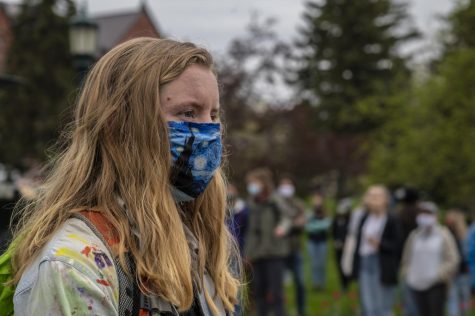
In a bid to avoid misunderstandings, Amy said she opted to bring Rickstad with her during her first meeting with Spence.
Rickstad, UVM’s only Campus Victim Advocate, declined to comment, stating in a May 10 email that she would have to go through a formal process and instead deferred to Erica Caloiero, interim vice provost for student affairs.
Although Amy said Spence appeared to be irritated during this initial meeting, it was the best interaction she had with her during the interview process.
“[Spence] listened, for the most part,” Amy said. “She seemed kind of annoyed and tired by the end because it took an hour to get my statement, but she seemed understanding, which I later found out was not actually the case.”
Following that first meeting, Amy said Spence unfairly censored her words by cutting her off when she attempted to speak about the nature of the relationship she had with her ex-boyfriend, who was her assaulter.
When Amy read the report, she said she saw Spence had allowed her ex-boyfriend to discuss aspects of their relationship at great length.
“[Spence] allowed [my abuser] to talk so much about things that had nothing to do with the night of the assault, when in my case, she was very adamant to have [me] stick to the subject of just the assault, so it didn’t really seem fair at all,” Amy said.
Amy’s ex-boyfriend could not be reached for comment.
Harting-Smith also said Spence asked questions that were inappropriate when trying to understand her case.
“I talked to Kate Spence, and I basically just went through my story with her, and she asked a lot of what I felt were inappropriate questions during, like what I was wearing, if I was acting drunk, if I was flirting with my assaulter that night,” Harting-Smith said.
Spence even went as far as to ask Harting-Smith about her sexuality which Harting-Smith said was uncalled for.
“She asked me what my sexual orientation was and I really [don’t] see how that matters,” Harting-Smith said.
Harting-Smith said her therapist told her Spence seemed to have already decided how things would go even in the midst of the investigation.
“My therapist told me she felt as though Kate Spence had made up her mind about the investigation before it was done,” Harting-Smith said.
What was more damaging to Hendrick was the fact that they couldn’t tell other survivors the Title IX reporting process is worthwhile, they said.
“It’s hard because after the investigation people had asked me, ‘you went through an investigation, what was it like,’ and I was just like, ‘horrible,’” Hendrick said.
When Amy received her own report, she said the description of her assault created by Spence was unsettling and inaccurate to her experience.
“He got validated and I was not believed,” Amy said.
I wrote my appeal saying that the facts were incorrect and that Kate was biased and the investigation wasn’t conducted in a very professional manner, and then my abuser was allowed to write a statement. Thomas Mercurio looked at both of them and decided the decision stands.
— Amy
When the Cynic requested data on the proportion of Title IX investigations that end in a ruling siding in favor of the survivor, AAEO Director Nick Stanton stated they do not compile such statistics.
“(AAEO) does not compile or publish statistics about the types of reports it receives, or the nature of actions taken in response to those reports,” Nick Stanton stated in a May 13 email.
Although the office itself does not have the data, the pattern is clear through the numerous voices of survivors who have come forward, stating their dissatisfaction with AAEO’s handling of their case reports.
The aftermath
After their formal investigations, both Amy and Harting-Smith filed appeals to have their cases re-evaluated, but neither one was successful in getting their appeal approved by student conduct appeals officer Thomas Mercurio.
“I wrote my appeal saying that the facts were incorrect and that Kate was biased and the investigation wasn’t conducted in a very professional manner, and then my abuser was allowed to write a statement,” Amy said. “Thomas Mercurio looked at both of them and decided the decision stands.”
Harting-Smith said she also tried for an appeal, but to no avail.
“I actually tried to appeal and then my appeal was denied,” Harting-Smith said. “My attorney said she would reach out to the school and try to set up a no contact order through the school, but I haven’t heard anything.”
After a certain time frame, it also becomes more difficult for survivors to go back and view their own AAEO case files if they so choose. AAEO uses a secure file transfer system to share investigation files from a link that expires after 30 days, according to a May 20 email from Stanton.
“If a party to an investigation no longer has a copy of or access to investigation documents that AAEO has already provided, AAEO can provide a copy of the investigative file to the party upon request,” Stanton’s email stated.
All three survivors suffered mental health and educational challenges after their cases were concluded.
Harting-Smith has struggled with her mental health since her assault and her investigation only made this worse, she said.
“Part of my PTSD is I’ll look at someone who looks like the person and quickly my brain will fill in the gaps and I’ll get really anxious all the time,” Harting-Smith said. “Since the investigation, I feel less safe on campus than I did before.”
After her case concluded, Amy said she regretted the entire reporting process because of all the stress it added to her semester and her schoolwork.
“It was an overall terrible experience,” Amy said.
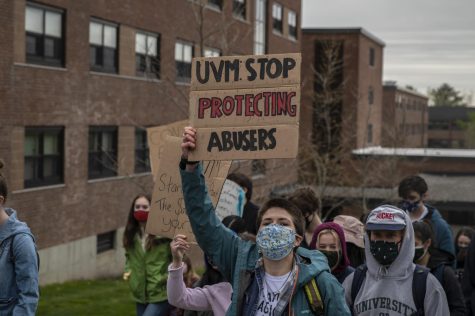
Although devastated by the conclusion of their case, Hendrick said they were coping well until Wieland approached them on campus and broke the no contact order.
“I [was] doing well in school, and then Austin talks to me and breaks the no contact order by coming up to me while he’s walking his dog,” Hendrick said. “I was really scared, I had a huge panic attack, I couldn’t sleep.”
Following the incident, Hendrick contacted AAEO to report Wieland breaking their contract, and again they said they were met with a lackluster response.
“They were like ‘okay we will remind him and also don’t walk alone and call the police and fill out a report if you want,’” Hendrick said.
The widely perceived harmful impacts of the Title IX investigation process have not only affected survivors who have gone through it, but also those that haven’t.
Senior Haley Sommer said she realized she had been assaulted by Wieland as well after reading Hendrick’s post but decided not to go through with an investigation, she said.
“I don’t know what to call what happened to me [but] I don’t want you to call it nothing,” Sommer said.
Although AAEO reached out to Sommer for an interview she decided not to go through with it, she said.
“I never went through any formal process of reaching out to the University, but they reached out to me after I shared my story on social media and asked if I was interested in going through the Title IX process and I declined,” Sommer said.
Demands to be addressed
UVM’s Student Title IX Advisory Committee put forth a comprehensive list of demands for the administration to address surrounded the handling of sexual assault at UVM, on April 30, which is backed by a petition that now has over 10,000 signers.
The University agreed to each of the demands, according to a May 3 email from Caloiero and Provost Patty Prelock. In a May 19 email, Caloiero and Prelock outlined relative timelines for meeting each demand and assigned specific administrative leaders to address each task.
In an interview with the Cynic, Caloiero said the demands put forth by the Student Title IX Advisory Committee were followed by multiple meetings between admin and students, in which administrators eventually listened and agreed with all the requests.
“We had a couple of meetings with students prior to sharing with the campus community [and] and we arrived at a ‘yes,’ in response to every request put forth,” Caloiero said.
One resolution that was reached between students and administrators is that there will be an independent audit of AAEO.
“If it had been internal we could have started it already but making sure that it’s independent, it’ll be done externally and so the timeline for that needs to be determined,” Caloiero said.
Many of the resolutions UVM committed to working on will be implemented over the summer, she said. Based on the independent nature of this audit, even the possibility of firing certain individuals in AAEO is not out of the picture, depending on the findings of the audit.
“Everything is on the table for review and for improvement,” Caloiero said.

(She/Her)
Kira Schaefer is a sophomore public communications major from Westchester, N.Y. and is super excited to start as the podcast editor for the...

(She/her) Ella Ruehsen is a senior environmental studies major with minors in political science and reporting and documentary storytelling. Before becoming...
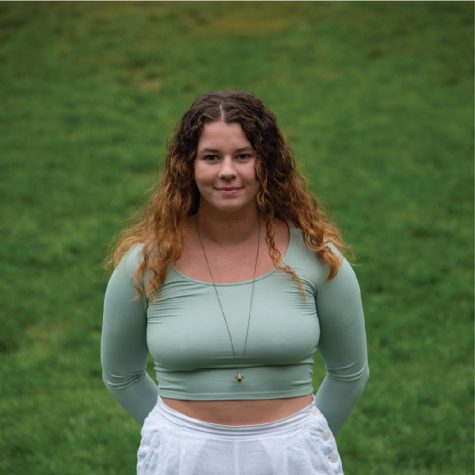
(She/her)
Kate Vanni is a senior Communications Design major with minors in Applied Design and Studio Art. Before becoming the Editor-in-Chief, Kate...


